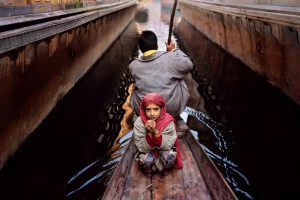The exhibit itself was blue. The walls on that floor were colored which seemed to me to be a cobalt blue. When you first walk onto the scene there are dimly lit lights that are directed to each photo separately, which I feel the intentions are to place a main focal point to each one individually as you walk by them. The physical space was moderate. It wasn’t too spacious, but it wasn’t too closed off either. The space was used smartly. You also had artifacts in glass standing in some of the open space. And seats were placed at least three feet away from the photos, perfect for sitting down and analyzing what’s on the wall. Although I can’t pin point how many pictures there were exactly, the pictures that were there were not overwhelming. There was enough to keep my interest, and not much that made me tired. But there were over 25 pictures. There were pictures that were broken into different categories, like time and specific places. Some were taken in 1996, 2001, 1983 etc. And some were taken in Chennai, northern India. But they were taken around the entire country of India. The type of pictures that were taken depicts the culture and religion of India. Some were of seasons, celebrations and normal day-to-day lives of many people.
The kinds of things that you see in theses pictures are very interesting. But one thing that does stand out from most of the pictures that were taken is the colors that were seen. There are reds, yellows, greens, and blues. The color was so vibrant. Color in the photos I feel represents life and happiness. There were pictures taken during monsoon season, where all the streets would be flooded but people could still be found outside. Others would be of cities, landscapes and monuments. For example, a train, with the Taj Mahal blurred out in the background. Others would be a portrait of one person, many people celebrating and animals in some cases. Some would be of things that were built very good and utilized often like the well that was used to collect water. I did not see any black and white pictures. Steve McCurry stated that he was glad she moved from black and white photography to color because the world we live in is in color. He also said color played a very important role in telling the story about life in India. Steve McCurry’s India is a place of enchantment, wonder and discovery. He also mentioned, “To tell the real story of this planet, it really needs to be in color…”
One photograph that I love in the exhibit is, Steve McCurry’s “Father and daughter on Dal Lake. Srinagar, Kashmir, 1996”. I like the fact that the little girl is in the center of the picture. And the color of her headscarf is depicted well off of her dad’s coat. The contrast of color of the water and the boat makes it easier to see the subject. I also like how the dad’s collar is yellow, which also makes him present in the picture. Since his face isn’t seen, he is not completely invisible. The little girls face is the only face seen which stresses her presence a lot more. The leading lines from the sidewalls make it easier to place the father and the daughter in the middle, making the picture look symmetrical in that way. I love it because of what it makes me understand from just only being a bystander. It shows you a different way of life. Her expression shows coyness with her eyes looking a bit powerful in the fact that she is looking straight into the camera. This photograph humbles me to my very core. Just looking at the boat they are on and the girls facial expression, it shows me some type of struggle that many of us in America would deem as tragic and sad. But through those experiences, determination is built and many people in third world countries become stronger and they work harder for a better life. It makes me appreciate what I already have.
When I initially looked at Steve McCurry’s photo of the Afghan girl, the first thing that caught my eye, were her eyes. Her eyes are of different colors, and she was looking into the camera so intensely. Her red scarf also frames her head that makes her the main focus of the picture. There was soft diffused light that made the picture look stand out even more. But the reason I think it became so iconic is because of her stare and demeanor and the way her eyes captured ours. I learned that there are people from around the world that look different but we are all still one. A person is a person regardless of their cultural identity. My biggest take away is that this world is such a beautiful place. The smile of faces that have been through hardships more often that others is just inspiring and gives many hope.





Beautifully written. You describe the exhibit and the work in it clearly and well. Steve McCurry’s use of color is outstanding. In the photo you selected, the whole image is basically browns and grays except the girls headscarf which is red. She is our focus. I think when we look at her we feel empathy and certainly not pity. A little different than how a father might take a daughter to school in New York City but we know the love and the care is there. It is good to feel gratitude for the good things we have.